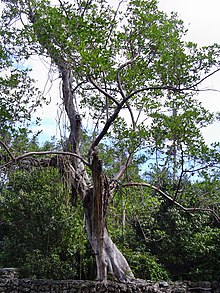| Florida strangler fig | |
|---|---|

| |
| Florida strangler fig in Deering Park, Florida | |
| Scientific classification | |
| Kingdom: | Plantae |
| Clade: | Tracheophytes |
| Clade: | Angiosperms |
| Clade: | Eudicots |
| Clade: | Rosids |
| Order: | Rosales |
| Family: | Moraceae |
| Genus: | Ficus |
| Subgenus: | F. subg. Urostigma |
| Species: | F. aurea
|
| Binomial name | |
| Ficus aurea Nutt. 1846, conserved name
| |
| Synonyms[3] | |
|
Synonymy
| |
Ficus aurea, commonly known as the Florida strangler fig (or simply strangler fig), golden fig, or higuerón,[4] is a tree in the family Moraceae that is native to the U.S. state of Florida, the northern and western Caribbean, southern Mexico and Central America south to Panama.[5] The specific epithet aurea was applied by English botanist Thomas Nuttall who described the species in 1846.
Ficus aurea is a strangler fig. In figs of this group, seed germination usually takes place in the canopy of a host tree with the seedling living as an epiphyte until its roots establish contact with the ground. After that, it enlarges and strangles its host, eventually becoming a free-standing tree in its own right. Individuals may reach 30 m (100 ft) in height. Like all figs, it has an obligate mutualism with fig wasps: figs are only pollinated by fig wasps, and fig wasps can only reproduce in fig flowers. The tree provides habitat, food and shelter for a host of tropical lifeforms including epiphytes in cloud forests and birds, mammals, reptiles and invertebrates. F. aurea is used in traditional medicine, for live fencing, as an ornamental and as a bonsai.
- ^ IUCN SSC Global Tree Specialist Group & Botanic Gardens Conservation International (BGCI) (2020). "Ficus aurea". IUCN Red List of Threatened Species. 2020: e.T181217702A181464731. doi:10.2305/IUCN.UK.2020-3.RLTS.T181217702A181464731.en. Retrieved 2 October 2022.
- ^ Cite error: The named reference
Brummitt2005was invoked but never defined (see the help page). - ^ "The Plant List".
- ^ Cite error: The named reference
Harvey1998was invoked but never defined (see the help page). - ^ Berg, C.C. (2007). "Proposals for treating four species complexes in Ficus subgenus Urostigma section Americanae (Moraceae)". Blumea. 52 (2): 295–312. doi:10.3767/000651907X609034.
